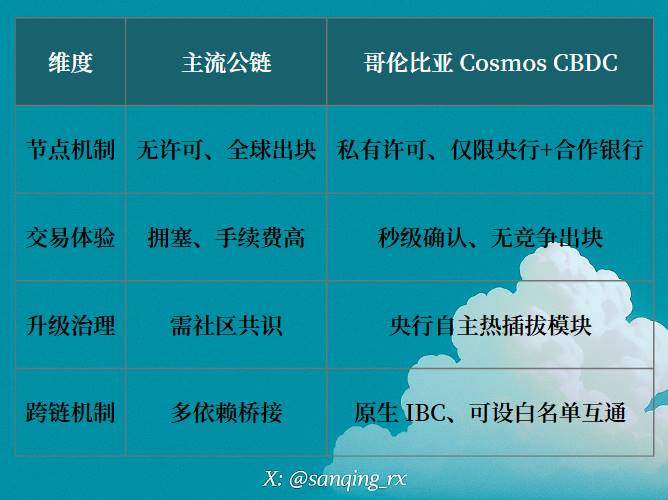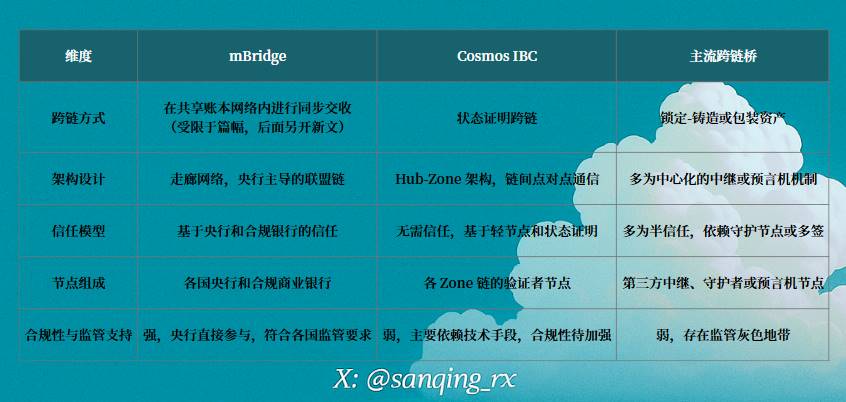Technology vs. Sovereignty: Cosmos Quietly Adopted by CBDC
Written by: Sanqing
Introduction
On May 22, 2025, Maghnus Mareneck, co-CEO of Interchain Labs, revealed that the Colombian government is working with a consortium of banks to test a CBDC for cross-border payment scenarios on the Cosmos network, and has opted for a private, permissioned node model and the IBC Eureka technology stack. Source: news.bitcoin.com There
is no DAO, no on-chain governance, only permissioned nodes and a distributed ledger. Who would have thought that Cosmos, known as the "decentralised Lego", would become an ideal partner for central bank digital currencies?
Cosmos: Building Blocks for Chains, Just the Right Jacket
of PowerCosmos is not a public chain, but a complete set of "chain building + through chain" toolbox, which is specially designed for multi-chain architecture. Compared with the standardised and open Ethereum, Cosmos's flexibility and controllability provide an ideal template for central banks to "customise the sovereign ledger".
Cosmos SDK: Assemble sovereign chains like Lego
TheCosmos SDK is a modular development framework that central banks can assemble as needed:
-
Add account permissions and KYC modules
-
Close the smart contract virtual machine to prevent "uncontrollable" contract deployment
-
Add regulatory audits, targeted payments and other regulatory plug-ins
Tendermint BFT: When the "central bank"
Cosmos uses Tendermint consensus in turn, it does not rely on computing power mining, but is rotated by authorised validators to produce blocks, with controllable node members, extremely low latency, strong block determinism, and natural adaptation to the real-time payment scenario of CBDC.
IBC: "TCP/IP" between chainsIBC
is the cross-chain communication protocol of Cosmos:
-
support proof of state and cross-chain
-
assets Zone chain is independent, exchange authentication packets when necessary,
-
implement chain-level whitelisting and packet review, "controllable interoperability" instead of disorderly interoperability
With the help of this protocol and the ICS-20 standard, tokens such as ATOM and OSMO can be freely circulated among multiple zones in the Cosmos ecosystem without bridging.
Hub-and-Zone: Rejection of reinventions L2
Cosmos' architecture is based on "Hub and Zone":
-
Cosmos Hub is the earliest chain in the ecosystem, but not the "commander-in-chief"
-
Zone refers to each independent chain, such as Osmosis and Juno, each chain has an independent ledger and validator
-
They communicate with each other via IBC without the need for a hub relay
Each zone is a "pluggable, autonomous operational" sovereign chain that communicates with each other, but does not need to obey.
Colombia Path: The sovereign abacus behind the technology selection
Colombia's CBDC chain is actually a zone using Cosmos technology.
-
Does not rely on Cosmos Hub
-
and does not directly interoperate with other DeFi ecosystems
-
It is a closed permissioned chain that only borrows the three major components of Cosmos SDK, Tendermint, and IBC

For the Central Bank of Colombia, This is not a decentralised "idealism", but an "instrumental" choice.
Cosmos vs. mBridge's Bifurcation: The Trade-Off Between Cost, Efficiency, and ControlWhen
it comes to the infrastructure selection of central bank digital currencies, Cosmos may not have expected itself to be one of the routes.
At present, the leading route is the Bank for International Settlements (BIS)-led mBridge, which cooperates with many countries - a consortium chain network that connects the CBDC networks of various countries (including central banks and international organisations, a total of 5 members, and more than 32 observer members), where the central banks of member countries set up Operator Nodes, which is a bit of a joint central bank, and allows commercial banks or other clearing and settlement institutions licensed by various countries to run nodes for currency exchange.
The author compares mBridge, Cosmos, and mainstream cross-chain bridges as follows:

didn't Colombia choose mBridge and switch to Cosmos?
On the one hand, mBridge is a product of the great power game, with a slow pace of technology update and a high access threshold. Cosmos, on the other hand, provides "out-of-the-box" technical components to build a native permissioned chain without complex negotiations or diplomatic coordination, while reserving the possibility of future interoperability through IBC.
This is more in line with the current realities of Latin American economies:
-
limited budgets, fast builds,
-
unwilling to rely solely on alliances dominated by specific powers
, -
and a desire to find a balance between compliance controls and blockchain innovation
If the pilot in Colombia goes well, Cosmos could become a new way for small and medium-sized economies to build sovereign digital currencies. A controlled, cost-acceptable, technology-dependent path is likely to be replicated by more sovereign states in South America, Africa, and even Southeast Asia. This is a classic triumph of "technical pragmatism".
ConclusionWhat
Cosmos provides is a kind of technical "neutrality" and "tailorability": it does not preset governance answers, nor does it reject centralised deployment.
Colombia didn't join Web3, it just borrowed Cosmos. There are no open nodes, no on-chain governance, and no connection to the public chain ecology - this Cosmos-based CBDC chain is more like a streamlined and modified "sovereign currency machine".
However, the "cooling adaptation" of this Web3 technology in real-world scenarios is also a kind of recognition of its engineering value.
